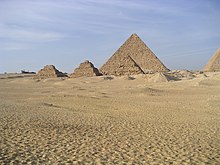| G3-a | |
|---|---|
 Pyramid G3-a, looking southwest | |
| Coordinates | 29°58′18″N 31°07′42″E / 29.97167°N 31.12833°E |
| Constructed | c. 2510 BC ( 4th dynasty) |
| Type | True Pyramid |
| Height | 28.4 meters (original) |
| Base | 44 meters (original) |
G3-a (also G3a, G3 c, GIIIa) is one of the three pyramid companions of the Pyramid of Menkaure. It is located on the south side of the Menkaure pyramid in the Giza Necropolis. It is the easternmost of the three pyramids of the queens. The pyramid was built during the Fourth Dynasty of Egypt, presumably for one of the wives of Menkaure. The American archaeologist George Andrew Reisner was "confident" that the structure housed Khamerernebty II, [1] [2] [3] but this is far from certain. [1]
It is a true pyramid, [1] with a base that is 44 metres (144 ft) square; its original height was 28.4 metres (93 ft). [4] The structure has a T-shaped chamber carved out of the bedrock, to which an entrance opens on the north face of the structure. [1] The American archaeologist Mark Lehner argues that this is akin to the layout of a satellite or ka pyramid. The fact that the structure once contained a pink granite sarcophagus, [1] however, has led scholars to speculate that it may have been reused as a queen's burial tomb, or that it served as a chapel where the body of Menkaure was mummified. [5] [6]

See also
References
Bibliography
- Dodson, Aidan; Hilton, Dyan (2004). The Complete Royal Families of Ancient Egypt. London: Thames & Hudson. ISBN 0-500-05128-3.
- Lehner, Mark (1997). The Complete Pyramids: Solving the Ancient Mysteries. London, UK: Thames & Hudson. ISBN 9780500050842.
- Reisner, George Andrew (1942). A History of the Giza Necropolis. Vol. III. Harvard University. (Note: This is the second unpublished follow-up to Reisner's work A History of the Giza Necropolis Vol. I, published by Harvard University Press)
- Verner, Miroslav (2007). The Pyramids: The Mystery, Culture, and Science of Egypt's Great Monuments. New York City, NY: Grove Atlantic. ISBN 9780802198631.
External links
| G3-a | |
|---|---|
 Pyramid G3-a, looking southwest | |
| Coordinates | 29°58′18″N 31°07′42″E / 29.97167°N 31.12833°E |
| Constructed | c. 2510 BC ( 4th dynasty) |
| Type | True Pyramid |
| Height | 28.4 meters (original) |
| Base | 44 meters (original) |
G3-a (also G3a, G3 c, GIIIa) is one of the three pyramid companions of the Pyramid of Menkaure. It is located on the south side of the Menkaure pyramid in the Giza Necropolis. It is the easternmost of the three pyramids of the queens. The pyramid was built during the Fourth Dynasty of Egypt, presumably for one of the wives of Menkaure. The American archaeologist George Andrew Reisner was "confident" that the structure housed Khamerernebty II, [1] [2] [3] but this is far from certain. [1]
It is a true pyramid, [1] with a base that is 44 metres (144 ft) square; its original height was 28.4 metres (93 ft). [4] The structure has a T-shaped chamber carved out of the bedrock, to which an entrance opens on the north face of the structure. [1] The American archaeologist Mark Lehner argues that this is akin to the layout of a satellite or ka pyramid. The fact that the structure once contained a pink granite sarcophagus, [1] however, has led scholars to speculate that it may have been reused as a queen's burial tomb, or that it served as a chapel where the body of Menkaure was mummified. [5] [6]

See also
References
Bibliography
- Dodson, Aidan; Hilton, Dyan (2004). The Complete Royal Families of Ancient Egypt. London: Thames & Hudson. ISBN 0-500-05128-3.
- Lehner, Mark (1997). The Complete Pyramids: Solving the Ancient Mysteries. London, UK: Thames & Hudson. ISBN 9780500050842.
- Reisner, George Andrew (1942). A History of the Giza Necropolis. Vol. III. Harvard University. (Note: This is the second unpublished follow-up to Reisner's work A History of the Giza Necropolis Vol. I, published by Harvard University Press)
- Verner, Miroslav (2007). The Pyramids: The Mystery, Culture, and Science of Egypt's Great Monuments. New York City, NY: Grove Atlantic. ISBN 9780802198631.